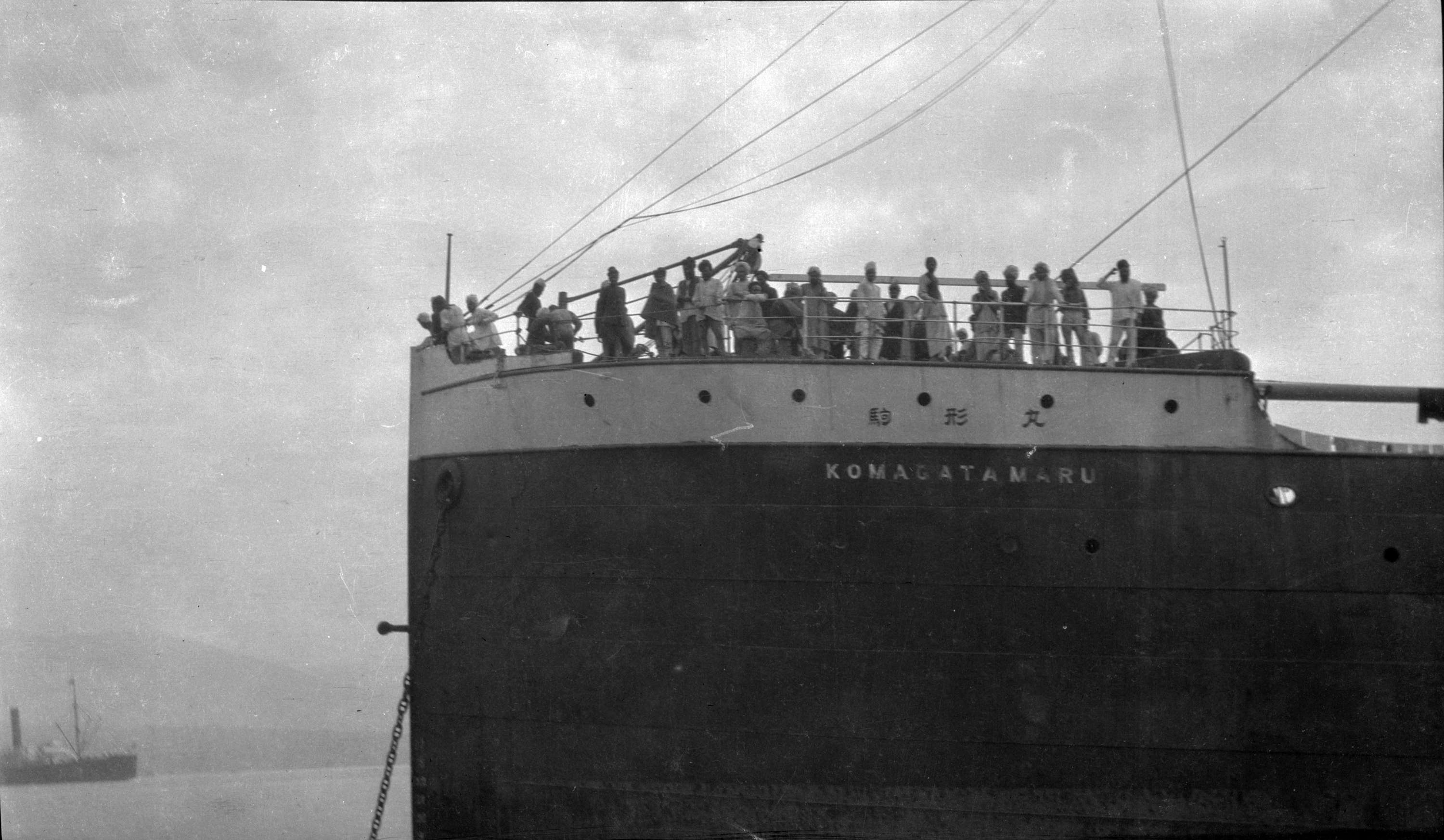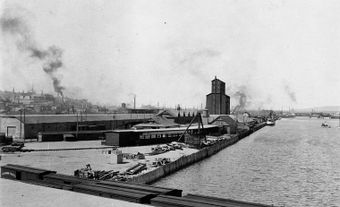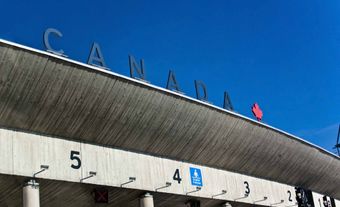The events in Vancouver illustrated the widespread assumption among white Canadians that Canada was “a white man’s country.” The whole story also exposed the fundamental unfairness of British rule in India, then the most prized colonial possession of the British Empire. It was one more proof for many South Asians of their second-class status within the Empire. From this perspective, the fall-out from the Komagata Maru was a noteworthy chapter in the history of the independence struggle in India. In 1914–15, the immediate impact was to encourage a small band of nationalists in an abortive armed uprising against British rule. In the longer term, the Komagata Maru was a factor in turning Indian public opinion against the British. (See also Immigration Policy; Prejudice and Discrimination.)
South Asians in Canada Before the Komagata Maru
A few thousand South Asians, mostly Punjabi men from India’s north, had migrated to British Columbia and the Pacific coast of the United States early in the 20th century. The vanguard found work at wages that were very high by Indian standards and they sent home letters encouraging their countrymen to follow.
Although their initial numbers were small, they attracted an inordinate amount of negative Canadian and American attention, prompted by cultural and racial prejudice and labour fears of economic competition. Anti-Asian lobbies in Canada and the United States were already fiercely opposed to Chinese and Japanese immigration, and they mounted a vigorous campaign against Punjabis and other South Asians. As a consequence, Canada stopped immigration from India in 1908 and the United States followed suit in 1910. To keep South Asians out, American immigration officials simply applied their existing regulations as ruthlessly as they could. Canadian officials, by contrast relied on two regulations first introduced in 1908 (see Immigration Policy).

By one of these regulations, immigration officers could — if they chose — block the entry of anyone who came to Canada other than by a continuous journey from their home country. This was effective because passenger agents — under instructions from the governments of India and Canada — would not sell natives of India through tickets to Canada. By another regulation, Canadian immigration officers were empowered to turn back any Asians who arrived with less than $200, a very large sum of money in 1914. (This did not apply to Chinese and Japanese, who were kept out by other measures). These two regulations were deliberately deceptive because, while they were designed solely to exclude immigrants from India, they did not state this as their direct purpose. That evasiveness was so that British imperial officials in India could deny the existence of any laws in Canada that barred Indian immigration.
After Canada and the United States stopped South Asian immigration, Punjabi and other South Asian activists concentrated on trying to reopen the door to Canada. They believed they had a more powerful argument in dealing with Canada than with the United States because, like India, Canada was a part of the British Empire. From the beginning, they were very persistent in supporting would-be-immigrants from India (including women and children), in fighting individual immigration cases in court, in lobbying officials in Ottawa, London and Delhi, and in publishing propaganda aimed both at white Canadian and South Asian audiences.
A moment of great encouragement came in November 1913 when a Canadian judge overruled an immigration department order for the deportation of 38 Punjabi Sikhs. These immigrants had come to Canada via Japan on a regularly scheduled Japanese passenger liner, the Panama Maru. Immigration officials had ordered them deported because they had not come by continuous journey from India and because they were not carrying the requisite amount of money. The judge found fault with the continuous journey regulation and also the regulation specifying a $200 requirement. He looked closely at the wording of these regulations and ruled them inconsistent with the wording of the Immigration Act and therefore invalid. He then allowed the passengers to land. It was this victory for the passengers in the Panama Maru case that encouraged the sailing of the Komagata Maru in the following April 1914.
Unfortunately, by April the legal situation had changed. The Canadian government had quickly rewritten its regulations to meet the objections it encountered in court. Although briefly invalidated, the continuous journey and $200 requirement regulations were back in force by January 1914, three months before the Komagata Maru left Hong Kong for Vancouver. The leadership of the Komagata Maru passengers might have been deterred from sailing after the reissue of these regulations. Instead, they convinced themselves that a Canadian court would rule in their favour. If that did not happen, they believed they could stir a great protest among Sikh troops in India, and so threaten the stability of the British Empire that the Canadian government would have to give way. On both counts, it turned out they were wrong.
Chartering the Komagata Maru
The individual who hired the Komagata Maru and who acted as chief spokesperson for the passengers was a wealthy Sikh named Gurdit Singh Sirhali who was then in his mid-50s. He had made his money as an importer and contractor in Malaya and Singapore although he had always maintained a home in his ancestral village in Punjab. His search for a ship to carry Punjabi immigrants to Canada had begun in December 1913, shortly after the Panama Maru case had led to a temporary lifting of the continuous journey and $200 regulations. Gurdit Singh had been visiting Hong Kong on his own private business, and while there he had met a large number of Punjabi men who were intent on emigrating to Canada or the United States. Some of these men had been in Hong Kong and other British-controlled ports of East Asia for many months and even years, hopefully waiting for a chance to cross the Pacific. Regular shipping lines would not take them in the knowledge that they would be turned back at the port of arrival and then be ordered back to Asia at the expense of the shipping company that brought them.
Gurdit Singh Sirhali’s search for a ship for these people took several months as he made inquiries in Kolkata, Singapore and Hong Kong. The ship he found, the itinerant Komagata Maru, temporarily in Hong Kong, was available precisely because it was not British owned or controlled, although it was a British-built ship. It was a steel-hulled steamship designed for the North Atlantic immigrant trade and it had operated under German ownership for over 20 years. Recently, it had been purchased by a small Japanese company for employment in the Pacific as a tramp cargo ship. Gurdit Singh hired it from this Japanese company through a German shipping agent in Hong Kong after getting nowhere in finding a ship through British shipping agents. One can infer that British shipping agents were dubious about a project that involved a legal challenge to Canadian law. It was fraught with political and legal problems and did not look like good business.
At nearly 3,000 tons, the Komagata Maru was a good size for the times and it was well equipped, possessing electric lighting and running water, although it did not have desalination equipment and could take on fresh water only when in port. (Water did become an issue when the ship was held for a long time in Vancouver. Yet the passengers did subsequently survive a long ordeal on board in remarkably good health.) When it had been a regularly scheduled immigrant ship carrying European immigrants from Baltic, Black Sea and Mediterranean ports, the Komagata Maru had accommodated nearly 550 steerage and 16 cabin passengers, a little more than Gurdit Singh intended to carry judging by the 533 bunks he had installed. He had enough room in the forward area of the main deck to create temple space for daily worship, led by a Sikh priest. The space was also used for political lectures and readings of emotional political poetry. For the passengers, that time in worship and in lectures and readings facilitated extraordinary cohesion, under the very difficult circumstances of a long confinement on board ship.

The Passengers and their Crossing to Vancouver
All of the passengers were Punjabis; and, with the exception of two wives and four children, all were men. Sikhs numbered at least 337, Muslims about 27 and Hindus about 12. (None of the passenger lists gives a precise basis for calculating figures on religious affiliation.) Most of the Muslims were from the Shapur District of western Punjab, now in Pakistan. Otherwise, the passengers were from farming villages and districts in central Punjab. There were three distinct groups: those from Doaba, north of the Sutlej River; those from Malwa, south of the Sutlej; and those from Majha, west of the Beas River. A large contingent came from Gurdit Singh’s Majha region and an even larger one from the Malwa region of his two principal lieutenants. Much smaller was the group from Doaba, although Doaba has been the main source of Punjabi immigration to Canada over the years. If men from Doaba had played a larger role in organizing the Komagata Maru, then this region might have been better represented on the ship. Trust between the organizers and potential passengers was an issue, and local loyalties were crucial in determining who went and who did not.
Nearly all of the passengers were from elite landowning village families rather than the low-status groups — notably weavers, leatherworkers and sweepers — that made up half of the village populations of rural Punjab. The sons of these landowning families were a chief source of recruits for the British Indian army. Many of the passengers had served in the army or in the police of Hong Kong, Shanghai, Singapore and other British outposts in East Asia. They were independent, self-financed or family-financed economic emigrants for whom emigration was a speculative venture aimed at personal and joint-family advancement. Because many spoke little or no English and all wanted to maximize earnings, they were generally looking for the outdoor jobs available to unskilled labourers — prepared to do menial work that they would not do in India. Judging by the established pattern of Punjabis in North America, most intended to stay overseas for several years in order to earn and save before returning home. Their long-term purpose was suggested by the choice made by nearly all of them to come without wives and children, even though many were married. The great attractions of North America were high wages and immediate investment opportunities in small businesses, farms and city lots. The real reward for their time overseas would be the money they took home for their families when they eventually returned.
At the time, few Canadians had any sympathy for the people on the Komagata Maru or believed that as subjects of the Empire they had a right to enter a self-governing country such as Canada. In fact, very few left-wing Canadians were able to sympathize with the anti-British, anti-imperial message that the passengers heard daily from Gurdit Singh’s young, politicized lieutenants. On board, these passengers received intense political education through lectures, readings from revolutionary literature and discussion. As a group, they were also self-selected to trust the leadership on the ship. Many others, who had originally planned to go from Hong Kong, had nervously dropped out after the Hong Kong police arrested Gurdit Singh on suspicion of fraudulently selling passages, only to release him without charges.
The ship sailed from Hong Kong on 4 April 1914 with just 150 passengers. To make up the numbers, Gurdit Singh sent two of his lieutenants to recruit passengers among Punjabis in the Philippines and in China. As the ship proceeded via Shanghai and the Japanese ports of Moji and Yokohama, these late recruits, travelling by regular liners, caught up. Some also came directly from India, making up the number of passengers to 376 by the time the ship left Japan.
The Treatment the Passengers Received in Canada
These passengers arrived in Canadian waters on 21 May 1914 and anchored in Vancouver’s harbor on 23 May. Gurdit Singh and his lieutenants knew that Canada had been rejecting South Asian immigrants for the previous six years and that they faced a likely struggle to gain entry for everyone. Nonetheless, Gurdit Singh, his lieutenants and the ordinary passengers were not prepared for the uncompromising measures taken by the Canadian authorities. None of the passengers was allowed ashore, even for preliminary examination, except for 20 returning residents and a very few special cases. The great majority found themselves confined to the ship throughout their time in Canadian waters.

A long confrontation ensued with the passengers resisting immigration department efforts to make them leave voluntarily. These efforts included limiting their communications with the outside world, blocking their attempts to take their case to a Canadian court, refusing to supply the ship with food and water except when conditions became desperate; and, at one point after a continuing standoff, attempting to take control of the ship by force with a police boarding party.

The passengers had Punjabi and other South Asian friends on shore who hired lawyers on their behalf, who also tried to negotiate with the officials, and who, on several occasions, sent out food and water when conditions on board became desperate. After a month, the two sides finally agreed to take a case to the British Columbia Court of Appeal. This case went ahead very quickly, but ended with a judgment in favour of the Canadian government and against the passengers. The court found no principle in Canadian or British law that gave the passengers a right of entry.
The Tragedy at Budge Budge and the Memory of the Komagata Maru
Gurdit Singh and the passengers accepted the decision of the British Columbia Court of Appeal without attempting an appeal to the Supreme Court of Canada or beyond that to the Judicial Committee of the British Privy Council in London. They had neither the resources nor willingness to continue a long legal struggle. Even so, their departure was delayed several more weeks. In an atmosphere of deep mistrust, the passengers and their friends on shore argued with government officials about who should provision the ship for its return. In the end, the Canadian government accepted the responsibility as far as Hong Kong. Finally, on 23 July, 355 disappointed and radicalized passengers left for Asia. After a long delay in Japan, where some passengers disembarked, 321 passengers reached the Indian port of Budge Budge near Kolkata on 29 September 1914. By then the First World War had begun. En route, the passengers made contact with German diplomats and exchanged friendly signals with a German cruiser, the Emden, which was then sinking British shipping in the Bay of Bengal.
Understandably, the revolutionary mood on the Komagata Maru had intensified even though these were dangerous times in India for any suspected opponents of the British. With the First World War underway, Indian troops were being recruited to fight alongside the British in the Middle East and Europe. For British officials in India, the uncertain loyalty of many of their Indian subjects was an immense concern. In this atmosphere, a deep-seated distrust affected the handling by British officials of the arrival of the Komagata Maru in India. Within hours of disembarking at Budge Budge, 20 of the passengers were killed in an encounter with British Indian police and troops who were unwilling to let the passengers disperse into Kolkata, and who tried to force them unwillingly onto a specially commissioned train bound for Punjab.
After the violence at Budge Budge, and the initial escape of most of the passengers, 27 avoided arrest despite an extensive police search in the region of Budge Budge and Kolkata. However, the majority were rounded up and held in a Kolkata prison until the Indian government completed a self-serving inquiry into the affair. By then, the passengers of the Komagata Maru had a reputation as dangerous revolutionaries, even in the minds of moderate Indian politicians whose perceptions were shaped by what they learned from a censored colonial Indian press. Only in the aftermath of the War, when the campaign for Indian independence intensified, did the passengers’ side of the story begin to emerge. Today, it is the generally accepted story.
Legacy
The Komagata Maru was quickly forgotten by most Canadians and it remained largely forgotten for several generations, except among Punjabi Canadians. Change came as Canadians became increasingly aware of a growing Punjabi and South Asian community in their midst, particularly after the 1970s. As late as 1961, and as a direct consequence of Canada’s anti-Asian immigration policies, the national census counted only 6,774 South Asians in the country. Ten years later, after immigration opened up, there were 67,925 and the numbers have doubled or more than doubled each decade since. By the 1990s, South Asians, particularly Punjabi Sikhs, were numerous enough to possess an unmistakable political presence.
As the centenary of the Komagata Maru grew closer, Canadian Sikhs began to push for an official apology. The idea, however, still ran into opposition from a sector of the voting public. In May 2008, the government of British Columbia officially apologized for the way the Komagata Maru's passengers were treated. In August 2008, Prime Minister Stephen Harper did deliver an apology at a fair organized by Sikhs in a park in Surrey, British Columbia. Many of the Sikhs present were unhappy with the place chosen for this apology. They wanted it delivered in the House of Commons in Ottawa, where comparable Canadian government apologies for past injustices against other minorities had been made (see Government Apology to Former Students of Indian Residential Schools). On 18 May 2016, Prime Minister Justin Trudeau formally apologized for the incident before the House of Commons: “Today — while knowing that no words can fully erase the pain and suffering experienced by the passengers — I offer a sincere apology on behalf of the government for the laws in force at the time that allowed Canada to be indifferent to the plight of the passengers of the Komagata Maru.”
Since 2012, a memorial dedicated to the Komagata Maru’s passengers stands at Coal Harbour in Vancouver. In May 2021, the City of Vancouver apologized for the Komagata Maru incident. The City Council also made 23 May an official day of remembrance. The City of New Westminster also issued an apology later that year in September.

 Share on Facebook
Share on Facebook Share on X
Share on X Share by Email
Share by Email Share on Google Classroom
Share on Google Classroom




